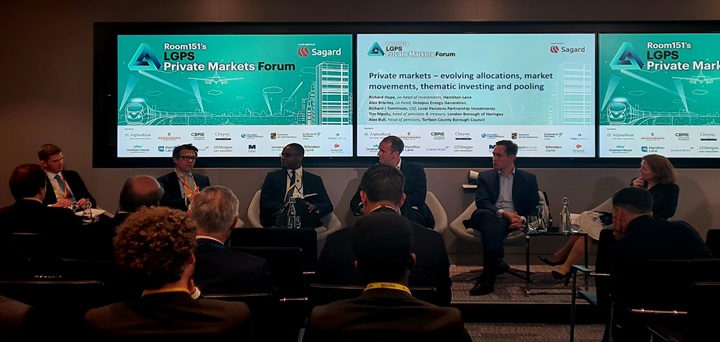
The London Stock Exchange, home of the UK’s listed equities market, hosted Room151’s second Private Markets Forum which again drew a full room of delegates and investors from across the LGPS. The event was kicked off by the chair for the day and CIO of London CIV, Aoifinn Devitt.
She described private markets as “one the most intriguing areas of storytelling in the world of investing”, acknowledging that it has the potential to spark conspiracy theories and mistruths.
Devitt highlighted that the more challenging macroeconomic and geopolitical backdrops for investors were likely to leave their mark on private markets, even though some sub-asset classes such as private equity and credit appeared to have been relatively resilient. She raised the question of whether challenges in real estate could become a canary in the coalmine for more difficult times to come.
Evolving allocations
Richard Hope, co-head of investments at Hamilton Lane, followed up by outlining the longer-term perspective for private market investments. He highlighted that over a ten year rolling period, private equity has outperformed public markets in relative terms.
Coming to the thorny question of whether private markets were overvalued, he argued that cumulative private equity returns were still below those seen during the dotcom bubble and the global financial crisis.
Having said that, he acknowledged that investors today faced a more challenging landscape and that many were concerned about distributions. “Transactions through secondaries and co-investments have been a good way of getting money to work,” he outlined.
Alex Bierly co-head of Octopus Energy Generation, then introduced the audience to the firm’s unique perspective to investing in renewable energy, which is largely driven by trends observed within the Octopus parent company, the UK’s largest supplier of renewable energy. “What we see happening within Octopus Energy and what our customers are asking for defines what we are investing in”, he stressed.
Putting this into practice, Tim Mpofu, head of pensions and treasury at Haringey, said that while much has been made of the liquidity requirements for the LGPS, his fund currently had a cash requirement of 0.5% and with an investment horizon spanning over multiple decades, it was able to take the benefit from accessing liquidity premia.
He was joined on the panel by Richard Tomlinson, CIO at LPPI, who countered the view that while many media headlines investors could book better returns in index funds, for larger investors allocating capital over the long-term, there was still very much a case for investing in private markets: “The idea that you can dump it all into US equity index trackers and walk away for ten years just doesn’t make sense”.
Alex Bull, head of pensions at Torfaen County Borough Council, which is part of the Wales Pension Partnership acknowledged that his fund had relatively lower exposures than some of his peers within the pool but that it remained important not to frontload the allocations and to ensure that the fund had sufficient capital available when interesting opportunities arose.
Demystifying private credit
If there has been one asset class which has dominated LGPS investment discussions in the past 12 months, it is private lending. But despite its popularity, myths and fears of shadow banking still abound, as Aoiffin Devitt stressed.
Stuart Fiertz, co-founder, president & head of responsible investment at Cheyne Capital, kicked off the discussion by outlining the fundamentals of the asset class. Drawing the distinction between sponsored and non-sponsored lending, he argued that the power dynamics in private lending had changed, rendering non-sponsored lending as relatively more attractive. “Think about the origination channels; this will give you a sense of the different dynamics between lender and borrower and the different power relationships. The borrower in a sponsored deal keeps the pen rather than the lender, which is why covenants are so weak in the sponsored world,” he stressed.
Emaad Sami, product & solutions director for infrastructure credit at Schroders Capital, outlined how investing in hard assets could offer investors some much needed downside and inflation protection in an increasingly uncertain macro environment. “Infrastructure debt has shaken its image of being all long duration, Solvency II friendly and a safe play for insurers. The market is now much more mature. You can have medium to short term duration strategies within that market with profiles not too dissimilar to direct lending,” he argued.
Raymond Wright, private markets portfolio manager at London CIV, outlined how the pool is diversifying its private credit offering. Having initially focused on senior direct lending, the pool now increasingly considers a broader array of private credit strategies. But he also expressed caution that the full impact of higher rates for private markets had not yet unfolded, stressing that it remained more important than ever to select experienced managers.
Philip Pearson, investment consultant at Hymans Robertson, argued that despite potential headwinds, private credit still had a role to play as a safety and growth asset. “There has been a tremendous diversification of the asset class since 2011 when senior loans to sponsor-backed mid-market corporates dominated the picture, with investor interest now going up and down the risk spectrum,” he said.
The long-term view
The event’s keynote speech was delivered by John Clark, founder and president of Performance Equity, a manager with $8.7bn of assets under management which is majority owned by Sagard and has committed around $30bn to private equity.
Clark pointed out that since the 1990s private equity has “dramatically changed” but that the principles around investing in the asset class have not, explaining that the company has managed to capitalise on private equity through venture capital and co-investments.
Over recent years, the UK government has been pushing pension funds, including the LGPS, to invest in private equity, particularly venture capital, although this has met some opposition from the investment industry due to its risk profile.
Many investors think that venture is “too risky”, and it can be, Clark explained. However, if you do it within a fund and with top-quartile managers, it is “not risky and offers investors significant outperformance”, he said.
Local impact
The discussion moved on to the political intervention in investment strategies, focusing on the government’s drive for LGPS funds to invest 5% of their assets into local impact projects.
Mark Lyon, deputy chief investment officer at Border to Coast Pensions Partnership, highlighted that there will always be government pressure to invest in the UK. So, all funds and pools can do is normal due diligence, selecting investment opportunities that they believe are the most appropriate.
However, he stated that Border to Coast is currently engaging with the government on greater political stability over the long term as often “short-term politics gets in the way”.
This comes as Border to Coast launched a UK opportunities strategy portfolio last year, which was formally launched in May 2024 with an additional £500m of commitments to invest in productive finance assets in the country.
Joining Lyon on the panel was Peter Bachmann, managing director for sustainable infrastructure at Gresham House, who highlighted that when it comes to creating impact, investors no longer have to sacrifice returns.
An example of this is investing in vertical farming, as produce can be grown at all times of the year, making the product attractive to supermarkets and therefore generating that income and return for investors, Bachmann said.
This sentiment was also echoed by Jos Seligman, investment director and fund manager at Swiss Life Asset Manager UK, which currently offers a UK-focused open-ended real estate fund.
Seligman stated that by committing to local impact investments, investors are making “long-term thematic decisions” and as long as you pick up the right trend, the commitments will be relevant in 30 years.
Market headwinds for infrastructure
The next panel discussion centred on infrastructure investment, with Edward Palmer, partner and CIO, head of sustainability at AlphaReal, setting the macroeconomic backdrop of high UK inflation and an absence of interest rate cuts. Alongside this, he also referenced the upcoming UK general election, which is set to take place on 4 July.
However, Palmer stated that despite these headwinds, investment into UK renewables, which AlphaReal has been investing in for 10 years, is still attractive to investors. Stephen Dowd, global infrastructure CIO at CBRE, also picked up on this point by suggesting that there is a growing need for these assets.
“For every area where there are headwinds, there are areas for opportunities. So, the need for grid capacity is enormous and there is a huge demand and when we talk about digital, the growth is fundamental. There is a big vein to tap into there,” Dowd said.
Nadeem Hussain, head of private markets at LGPS Central, argued that these headwinds had also not yet manifested themselves for the pool. Due to the pension pool’s balance between open-ended and close-ended funds, the macroeconomic environment has not impacted the income produced from its infrastructure assets. However, he noted that closed-ended funds had reported relatively slow growth.
Adil Manzoor, head of private markets at Merseyside Pension Fund, stated that political headwinds present an issue for overall investment into the area, with cyber security being a critical threat to infrastructure assets. In addition, with the increase in interest rates, it is taking more time to see the true value of the assets.
Stay tuned for the afternoon sessions from the event which will be covered tomorrow.
—————
FREE weekly newsletters
Subscribe to Room151 Newsletters
Follow us on LinkedIn
Follow us here
Monthly Online Treasury Briefing
Sign up here with a .gov.uk email address
Room151 Webinars
Visit the Room151 channel










